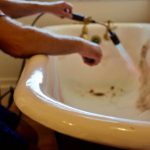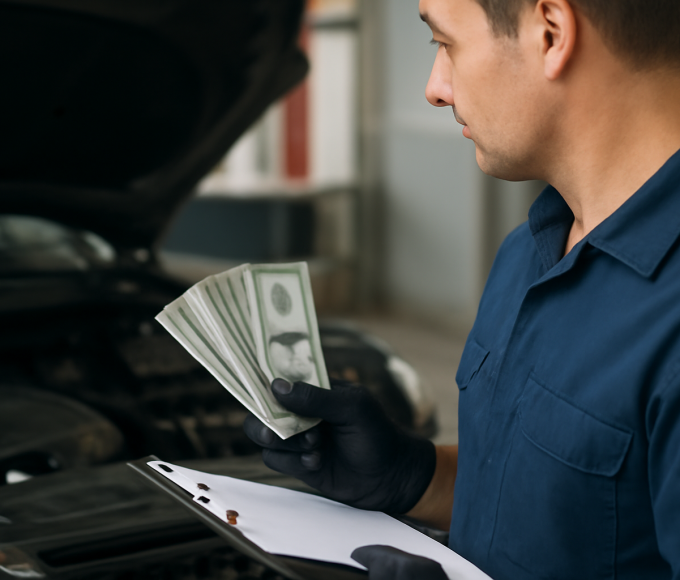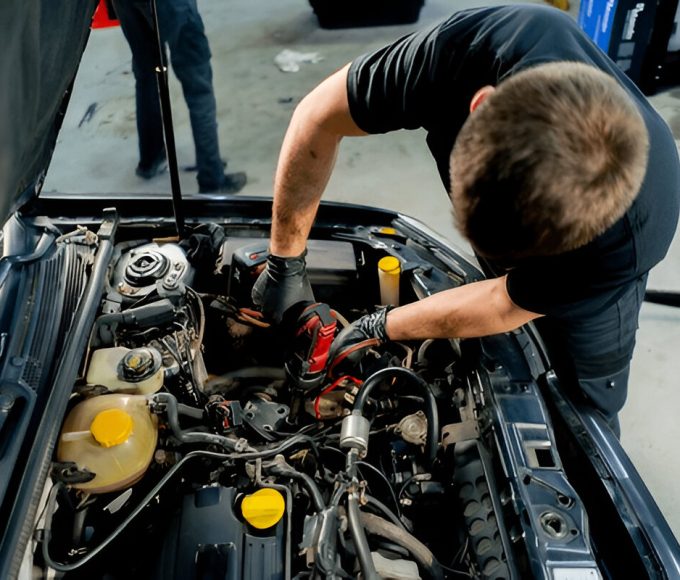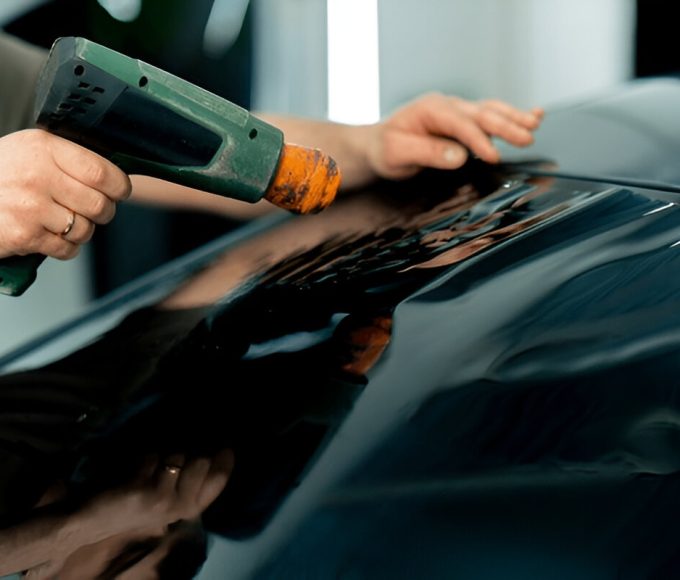A minor scratch isn’t just cosmetic—it exposes your paint system to sun, moisture, and road grime, which can snowball into oxidation, rust, and even ding resale value. The good news: with a measured approach, the right materials, and a clean workspace, you can also restore gloss, seal the finish, and keep your car looking new. In the next few minutes, you’ll learn to identify scratch depth, choose the correct method, and execute clean, durable repairs. So, you’ll know how to repair auto paint scratches efficiently, safely, and without overspending.
Scratch Types & How To Repair Auto Paint Scratches
Before you touch a polishing pad, confirm what you’re dealing with. Your vehicle’s finish is a layered system: clear coat (gloss/UV protection), base coat (color), primer (adhesion/seal), and finally the metal or plastic substrate. The table below shows what to do based on depth.
| Scratch type | Depth tell-tale | DIY difficulty | Core fix | Typical time |
| Clear coat scuff | Nail doesn’t catch; no color change | Easy | Polish or light compound, then seal | 20–40 min |
| Base coat scratch | Nail lightly catches; color looks dull/white | Moderate | Touch-up paint + level + polish | 60–120 min |
| Primer/deep | Metal/primer visible; nail digs in | Advanced | Fill/paint/level; may need pro | 2–4 hrs. (DIY) |
| Rock chips | Pinpoint craters on front surfaces | Moderate | Touch-up + clear build + level | 45–90 min |
| Keyed panels/large damage | Long, jagged grooves across panels | Hard | Multi-stage, pro respray likely | 1–3 days (shop) |
What You’ll Need to Start — How to Repair Auto Paint Scratches
Use clean, quality tools so you remove defects—not add new ones.
- Workstation basics: shade, good lighting, nitrile gloves, masking tape, soft fender cover.
- Washing & prep: pH-balanced car wash soap, two buckets with grit guards, microfiber wash mitt, drying towels, isopropyl alcohol (IPA) mix (10–20%) for final wipe.
- Abrasives & leveling: 1000- and 2000-grit wet/dry sandpaper, a small foam sanding block, and a fine/ultrafine rubbing compound.
- Polishing and protection: Finishing polish, microfiber or foam applicators, a dual-action (DA) polisher, and quality wax or paint sealant.
- Color correction: OEM-code touch-up paint (pen, bottle, or aerosol), ultra-thin brush/toothpick, and clear coat (pen or aerosol) for building gloss.
- Detailing aids: panel wipe, tack cloth, and plastic razor blades for cleaning edges without marring.
Step-by-Step Repairs For Scratch Depth
These steps give you a precise, repeatable process. Work slowly, check your progress often, and stop when the defect is removed. You’ll master how to repair auto paint scratches without over-thinning the clear.
A) Clear Coat Scuffs (Door Handle Cups, Shopping-Cart Kisses)
- Wash & decontaminate. Thoroughly wash, then wipe the spot with a light IPA mix to remove waxes that could clog your pad.
- First, test the spot. Then, a pea-sized drop of fine compound was applied using a foam applicator. Work a 10 × 10 cm area in overlapping passes for ~30 seconds.
- Inspect. Wipe clean. If the haze diminishes but persists, make one shorter pass. Avoid heat buildup; keep the pad moving.
- Refine. Follow with finishing polish to restore optical clarity.
- Seal. Apply wax or sealant to protect the corrected area.
Why it works: You’re leveling the top microns of clear coat so the scratch is no longer a valley that scatters light.
B) Base Coat Scratches (Branch Rubs, Larger Debris)
When you can faintly feel the mark with a fingernail but don’t see bare metal, touch-up paint plus leveling is your path. Here’s how to repair auto paint scratches at this depth:
- Clean & mask. Wash, de-wax with IPA, and mask an outline around the scratch so you keep the product where it belongs.
- Color match. Confirm the OEM paint code (driver-door jamb or owner’s manual). Shake the bottle or pen thoroughly.
- Paint application. With a fine brush or toothpick, wick tiny amounts of color into the scratch—don’t flood it. Capillary action should fill the groove. Let it flash, then apply additional thin passes until the color is just shy of flush.
- Cure. Allow the color to dry fully per the manufacturer (often a few hours or overnight).
- Build clearly. Add 2–3 thin coats of clear to rise slightly above the surrounding surface—this “proud” layer gives you material to level perfectly.
- Level. Wet lightly sand with 2000-grit on a small foam block using soapy water. Keep strokes short and localized until the repair is flush.
- Polish. Use a compound to remove sanding haze, then a finishing polish for gloss.
- Seal. Protect with wax/sealant to ensure even water behavior across the panel.
Key caution: The curing time wasn’t sufficient if the color lifted onto your towel while wiping. Pause and let it harden.
C) Primer/Deep Scratches
Deep grooves expose primer or metal, which can rust. You can DIY small sections, yet large or complex panels are often better left to a body shop.
- Feather edges. Sand jagged paint edges with 1000-grit to create a smooth, tapered trough.
- Prep & protect. Clean with panel wipe; mask edges and trim. If bare metal is visible, apply a thin etching primer touch-up to prevent corrosion, then allow it to dry.
- Color and fill. Apply color in multiple thin passes. If the trough is deep, use a compatible filler/putty first, level it, and then color.
- Clear build. Stack clear layers until the repair sits slightly proud of the surrounding finish.
- Block level. Wet sand with 2000-grit on a small block to flatten the repair flush with the panel. Keep the surface wet and check often.
- Compound & polish. Remove micro-marring and restore clarity.
- Final protection. Seal the area and inspect in direct and diffused light.
If the scratch crosses body lines or is longer than ~20–25 cm, a pro respray may be faster, more uniform, and cost-effective long-term.
Common Mistakes and How to Avoid Them
- Skipping wash/decon: Dirt on the surface becomes fresh scratches under your pad—always clean first.
- Too much pressure: Pressing harder doesn’t fix faster; it just thins the clear coat and adds haze. Let abrasives work.
- Rushing cure times: Touch-ups that aren’t fully cured will smear during leveling. Wait as directed.
- Over-sanding: Sand only the high spot of the repair, not the whole panel. Use a small block and short strokes.
- Wrong compound/pad: Heavy-cut products on soft clear can micro-mar; test fine first, then step up only if needed.
- No protection afterward: Unsealed corrections re-oxidize faster; always finish with wax or sealant.
Cost And Professional Repair Timeline For Paint Scratches
The price of professional scratch repair depends on the depth and size of the damage. Minor spot treatments, such as polishing clear coat scuffs or filling a few chips, usually cost $100–$300. Larger jobs, like deep base coat scratches or multi-panel blends, range between $500 and $1,500+, depending on the paint type, labor, and materials.
Timeline also varies by severity. Small clear coat corrections can often be done in less than an hour, while touch-up and leveling may take a few hours to a full day. For deeper scratches that require primer, filler, or a full respray, shops usually need 1–3 days, especially if multiple coats or drying cycles are involved.
Tip: Mobile detailers can handle light to moderate scratches at your driveway, saving time, while body shops remain the best choice for deep or widespread damage.
When to DIY vs. Call a Pro
You can learn how to repair auto paint scratches for small, localized defects. Yet there’s a point of diminishing returns:
- The DIY sweet spotis isolated, clear scuffs, a few rock chips, or short base-coat lines on flat areas. Expect to spend the price of compounds, pads, and paint pens.
- Shop territory: large keyed panels, damage on sharp creases, tri-coat pearls across big areas, or any repair that exposes metal over a wide region. Professional body shops can blend adjacent panels so that metallic flake orientation and gloss match seamlessly, which is difficult at home.
Typical costs vary by region and size, but minor pro spot repairs may range from $100–$300, while multi-panel blends can reach $500–$1,500+, depending on materials and labor. Meanwhile, mobile detailers can perform polishing and light touch-ups at your driveway, saving time.
Care That Prevents Scratches
Prevention is faster and cheaper than correction. Initially, establish a wash routine: use a two-bucket method, soft mitt, separate wheels bucket, and blot-dry with plush microfiber. Next, keep 6–8 car lengths behind gravel-flinging trucks; avoid tailgating on newly resurfaced roads. Additionally, park away from cart corrals and under cover when possible. Finally, maintain a sacrificial layer—quality wax or sealant—every 2–4 months (or a ceramic coating for year-round protection).
As you build good habits, you’ll also need to figure out how to repair auto paint scratches, and your chances of getting them repaired will drop dramatically.
Troubleshooting: If the Repair Still Shows
Sometimes a line remains visible at certain angles. Consequently, ask yourself:
- Is the scratch level? If not, add one clearer coat layer and re-level gently.
- Is the color off? Recheck the paint code; many colors have multiple variants by factory lot.
- Is there sanding haze? Step down to a finer polish and also slow your arm speed.
- Is the panel plastic? You may see texture (“orange peel”) that requires careful refinement, not just gloss.
If you’ve tried these and the defect still pops up under bright sun, consult a professional for a blend.
Final Checklist + Timeline
- Day 0 (evening): Wash, de-wax, assess, and stage tools.
- Day 1 (morning): Perform clear-coat polishing or apply base-coat touch-up in thin layers.
- Midday: If needed, add more color; let it fully flash.
- Afternoon: Build clear to slightly proud, then pause.
- Day 2: Wet-sand lightly, compound, polish, and seal.
- Week 1: Wash gently. Admire the uniform gloss and note that you now know how to repair auto paint scratches correctly.
FAQs
Can I fix deep scratches on my car at home?
Yes, small deep scratches can be repaired with filler, primer, touch-up paint, and clear coat, but large or complex damage is best left to a professional.
How much does professional scratch repair usually cost?
Minor spot repairs may cost $100–$300, while larger resprays or multi-panel blends can range from $500 to $1,500+.
How do I know if my scratch only needs polishing?
If your fingernail doesn’t catch and there’s no color change, it’s likely a clear-coat scuff that can be polished out.
Drive Away with Confidence
Scratches happen—to careful drivers, too. Nevertheless, armed with a thoughtful plan, you can diagnose depth, choose the lightest effective method, and execute a tidy repair that blends in and endures. Furthermore, with smart washing, mindful driving distance, and regular protection, you’ll spend far less time fixing and far more time enjoying a clean, glossy car. And because you’ve learned exactly how to repair auto paint scratches, you’ll be ready when the next little scuff inevitably appears.

















Leave a comment